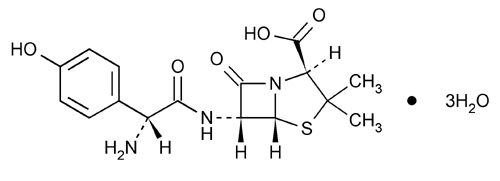Amoxicillin
4-Thia-1-azabicyclo[3.2.0]heptane-2-carboxylic acid, 6-[[amino(4-hydroxyphenyl)acetyl]amino-3,3-dimethyl-7-oxo-, trihydrate 2S-[2
(2S,5R,6R)-6-[(R)-(
Anhydrous 365.41
» Amoxicillin contains not less than 900 µg and not more than 1050 µg of C16H19N3O5S per mg, calculated on the anhydrous basis.
Packaging and storage—
Preserve in tight containers, and store at controlled room temperature.
Labeling—
Where it is intended for use in preparing injectable dosage forms, the label states that it is intended for veterinary use only and that it is sterile or must be subjected to further processing during the preparation of injectable dosage forms. Label all other Amoxicillin to indicate that it is to be used in the manufacture of nonparenteral drugs only.
Identification, Infrared Absorption  197K
197K .
.
Crystallinity  695
695 :
meets the requirements.
:
meets the requirements.
pH  791
791 :
between 3.5 and 6.0, in a solution containing 2 mg per mL.
:
between 3.5 and 6.0, in a solution containing 2 mg per mL.
Water, Method I  921
921 :
between 11.5% and 14.5%.
:
between 11.5% and 14.5%.
Dimethylaniline  223
223 :
meets the requirement.
:
meets the requirement.
Other requirements—
Where the label states that Amoxicillin is sterile, it meets the requirements for Sterility and Bacterial endotoxins under Amoxicillin for Injectable Suspension. Where the label states that Amoxicillin must be subjected to further processing during the preparation of injectable dosage forms, it meets the requirements for Bacterial endotoxins under Amoxicillin for Injectable Suspension.
Assay—
Diluent—
Dissolve 13.6 g of monobasic potassium phosphate in 2000 mL of water, and adjust with a 45% (w/w) solution of potassium hydroxide to a pH of 5.0 ± 0.1.
Mobile phase—
Prepare a suitable filtered mixture of Diluent and acetonitrile (96:4). Make adjustments if necessary (see System Suitability under Chromatography  621
621 ). Decrease the acetonitrile concentration to increase the retention time of amoxicillin.
). Decrease the acetonitrile concentration to increase the retention time of amoxicillin.
Standard preparation—
Quantitatively dissolve an accurately weighed quantity of USP Amoxicillin RS in Diluent to obtain a solution having a known concentration of about 1.2 mg per mL. Use this solution within 6 hours.
Assay preparation—
Transfer about 240 mg of Amoxicillin, accurately weighed, to a 200-mL volumetric flask, dissolve in and dilute with Diluent to volume, and mix. Use this solution within 6 hours.
Chromatographic system
(see Chromatography  621
621 )—The liquid chromatograph is equipped with a 230-nm detector and a 4-mm × 25-cm column that contains packing L1. The flow rate is about 1.5 mL per minute. Chromatograph the Standard preparation, and record the peak responses as directed for Procedure: the capacity factor, k¢, is between 1.1 and 2.8, the column efficiency is not less than 1700 theoretical plates, the tailing factor is not more than 2.5, and the relative standard deviation for replicate injections is not more than 2.0%.
)—The liquid chromatograph is equipped with a 230-nm detector and a 4-mm × 25-cm column that contains packing L1. The flow rate is about 1.5 mL per minute. Chromatograph the Standard preparation, and record the peak responses as directed for Procedure: the capacity factor, k¢, is between 1.1 and 2.8, the column efficiency is not less than 1700 theoretical plates, the tailing factor is not more than 2.5, and the relative standard deviation for replicate injections is not more than 2.0%.
Procedure—
Separately inject equal volumes (about 10 µL) of the Standard preparation and the Assay preparation into the chromatograph, record the chromatograms, and measure the responses for the major peaks. Calculate the quantity, in µg, of C16H19N3O5S per mg of the Amoxicillin taken by the formula:
200(CP / W)(rU / rS)
in which C is the concentration, in mg per mL, of USP Amoxicillin RS in the Standard preparation; P is the stated amoxicillin content, in µg per mg, of USP Amoxicillin RS; W is the quantity, in mg, of Amoxicillin taken to prepare the Assay preparation; and rU and rS are the amoxicillin peak responses obtained from the Assay preparation and the Standard preparation, respectively.
Auxiliary Information—
Please check for your question in the FAQs before contacting USP.
Chromatographic Column—
| Topic/Question | Contact | Expert Committee |
| Monograph | Ahalya Wise, M.S.
Scientist 1-301-816-8161 |
(MDANT05) Monograph Development-Antibiotics |
| Reference Standards | Lili Wang, Technical Services Scientist 1-301-816-8129 RSTech@usp.org |
USP32–NF27 Page 1540
Chromatographic columns text is not derived from, and not part of, USP 32 or NF 27.
